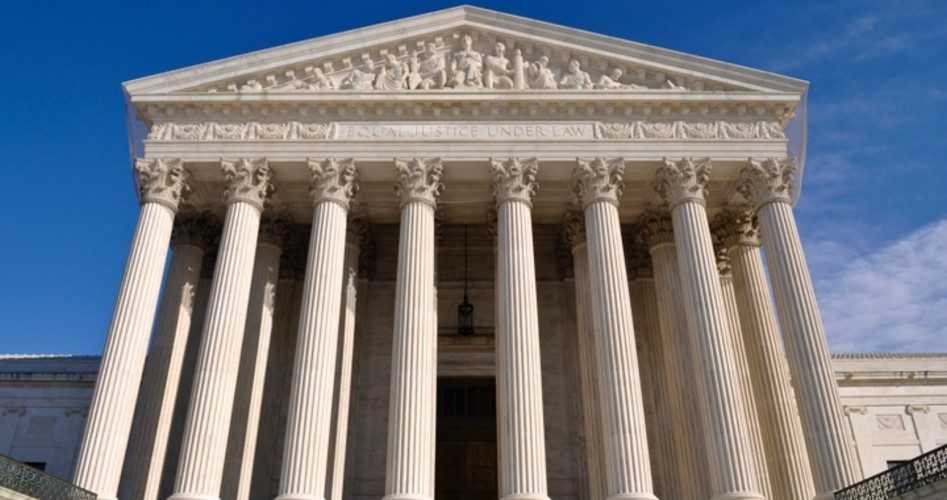
In a 5-3 decision, the Supreme Court on June 27 reversed the judgment of an appeals court last year that upheld a Texas law placing restrictions on abortions — effectively striking down the law. The ruling held that the 2013 Texas law placed an undue burden on women exercising their “constitutional” right to have an abortion — a right found nowhere in the Constitution but established in the landmark 1973 Roe v. Wade decision, which stated that the right to abortion falls under the “penumbra” of the right to privacy.
The ruling has been described as the most significant Supreme Court decision from the Supreme Court on abortion in two decades and could serve to deter other states from passing laws establishing restrictions similar to the Texas law, which did not ban abortion but merely imposed certain restrictions to safeguard the health of the patients. These included requiring doctors have to have local admitting privileges at nearby hospitals, and requiring the clinics have to upgrade their facilities to hospital-like standards.
Texas is but one of several states that have passed laws requiring abortionists to have nearby hospital admitting privileges. Other include Tennessee and Utah. However, courts have temporarily prevented enforcement of similar laws in Alabama, Kansas, Mississippi, North Dakota, and Wisconsin.
A federal appeals court upheld the law in 2015. In a 5-4 vote last November 19, the Supreme Court refused an emergency application filed by Planned Parenthood and several Texas abortion clinics to overturn the preliminary federal appeals court ruling.
Speaking for the majority voting not to block the Texas law, the late Justice Antonin Scalia said that the appeals court’s earlier decision was based on its conclusion that Texas officials were likely to prevail in the case, with the new statute being upheld as constitutional.
Scalia wrote at the time that the justices owed deference to the appeals court’s conclusion, noting: “It would flout core principles of federalism by mandating postponement of a state law without asserting that the law is even probably unconstitutional.”
However, in the spring a majority of the Supreme Court voted to stay the appeals court ruling, pending appeal. Four of the court’s justices at the time: Chief Justice John Roberts, Clarence Thomas, Samuel Alito, and Scalia, publicly stated that they would have denied the stay.
With Scalia gone, one might have expected another tied decision, such as the one on June 23 in the case of United States v. Texas (related to the Obama administration’s amnesty for illegal aliens). So the 5-3 vote in this case is another significant development. Justice Anthony Kennedy (usually regarded as the “swing” vote on the court) voted with justices Stephen Breyer, Ruth Bader Ginsburg, Sonia Sotomayor, and Elena Kagan. Two of the justices who voted to strike down the restrictions on abortion (Kennedy and Sotomayor) identify themselves as Catholic, which places them at odds with the teaching of their church on abortion. Paragraph 2270 of the Catechism of the Catholic Church reads:
Human life must be respected and protected absolutely from the moment of conception. From the first moment of his existence, a human being must be recognized as having the rights of a person — among which is the inviolable rights of every innocent being to life.
Those words mirror the language found in the Declaration of Independence: “We hold these truths to be self-evident, that all men are created equal, that they are endowed by their Creator with certain unalienable Rights, that among these are Life, Liberty and the pursuit of Happiness.”
It is expected that today’s ruling will have an impact on the presidential election, since speculation concerning the outcome of the election and what sort of candidate each potential victor would nominate to replace Scalia have already fueled much discussion.
Speaking with Fox News TV host Bill O’Reilly last month, presumptive Republican nominee Donald Trump said, “I will protect” the sanctity of life, “and the biggest way you can protect it is through the Supreme Court and putting people in the court, and actually the biggest way you can protect it, I guess, is by electing me president.”
In contrast, there is little speculation about what sort of candidate to the High Court presumed Democratic nominee Hillary Clinton would nominate.
Hillary Clinton immediately praised today’s Supreme Court ruling, tweeting:
SCOTUS’s decision is a victory for women in Texas and across America. Safe abortion should be a right — not just on paper, but in reality. — H
From the 5-3 vote on today’s case (Whole Woman’s Health v. Hellerstedt), it is apparent that even if a fairly conservative justice were to be appointed to replace Scalia, achieving a court that would rule favorably to the pro-life side on matters of abortion is far from a certainty. As we just saw, five justices — a majority even if the court had all nine seats filled — voted to strike down a law that imposed only very modest restrictions on abortionists. It came nowhere close to banning the procedure. Therefore, any hope of reversing Roe v. Wade in the foreseeable future is overly optimistic.
Those who wish to defend the rights of the states to restrict abortion must therefore rely on other strategies. The two that most often come to mind are nullification and congressional removal of jurisdiction from the Supreme Court in any case that pertains to abortion. Nullification is, as Thomas Jefferson wrote, the “rightful remedy” to federal overreach.
Much has been written about the concept of nullification, including several articles posted by The New American. A prime example of this principle was explored in an article in The New American last February that observed how the state legislature of Tennessee was considering a pair of companion bills that would amend the Tennessee state code to prohibit “state and local governments from enforcing, administering, or cooperating with the implementation, regulation, or enforcement of any federal executive order or U.S. supreme court opinion unless the general assembly first expressly implements it as the public policy of the state.”
Another article published by The New American in 2014 was particularly relevant to this latest ruling on a Texas law, since it described legislation introduced by Texas lawmaker Dan Flynn that would have invalidated within the sovereign borders of his state every act of the federal government that exceeds its constitutionally derived authority. Flynn’s bill (officially titled the Texas Balance of Powers Act) would have denied the federal government “the power to take any legislative, executive, or judicial action that violates the constitution, specifically including those actions that unconstitutionally undermine, diminish, or disregard the balance of powers between the states and the federal government established by the constitution.”
As we noted in our article, if nullification is to be successfully deployed and defended, “other states lawmakers must follow Flynn’s example and remember that the Constitution is a creature of the states and that the federal government was given very few and very limited powers over objects of national importance.”
We also quoted James Madison’s defense of federalism and states’ rights in Federalist 45, noting: “The powers delegated by the proposed Constitution to the federal government, are few and defined. Those which are to remain in the State governments are numerous and indefinite.”
The author of that article, Joe Wolverton, noted:
Nullification, as defined by Jefferson and Madison, and understood so well by Representative Flynn, is the most powerful weapon against the federal assault on state sovereignty and individual liberty. By applying the principles repeated in [the Texas Balance of Powers Act], states can simultaneously rebuild the walls of sovereignty once protected by the Constitution, in particular the Tenth Amendment, and drive the forces of federal consolidation back inside the constitutional cage meant to restrain them.
The other strategy that might successfully be used to protect the rights of the states to restrict or ban abortion (a right that was recognized before Roe v. Wade) would be for Congress to exercise its power granted to it under Article III, Section 2 of the Constitution, which states that “The Supreme Court shall have appellate Jurisdiction, both as to Law and Fact, with such Exceptions, and under such Regulations as the Congress shall make.” (Emphasis added.)
By this language, Congress has the power to make exceptions to and to regulate the jurisdiction of the Supreme Court. Legislation to use this provision to remove the jurisdiction of the High Court over cases related to abortion was introduced in several congresses. The bills in question carried the title “Sanctity of Life Act” and were first introduced in the House by Representative Steve Stockman (R-Texas) on July 20, 1995, and cosponsored by Representative Barbara Cubin (R-Wy.) It was reintroduced with similar text by Representative Ron Paul (R-Texas) in the 109th, 110th, 111th, and 112th congresses. (Which were in session from 2005-2013.)
Representative Walter Jones (R.-N.C.) introduced the Sanctity of Life Act of 2015 (H.R. 2761) in the current Congress. The part of the bill addressing the limitation of jurisdiction reads:
Notwithstanding the provisions of sections 1253, 1254, and 1257 of this chapter, the Supreme Court shall not have jurisdiction to review, by appeal, writ of certiorari, or otherwise, any case arising out of any statute, ordinance, rule, regulation, practice, or any part thereof, or arising out of any act interpreting, applying, enforcing, or effecting any statute, ordinance, rule, regulation, or practice, on the grounds that such statute, ordinance, rule, regulation, practice, act, or part thereof (1) protects the rights of human persons between conception and birth, or (2) prohibits, limits, or regulates (a) the performance of abortions or (b) the provision of public expense of funds, facilities, personnel, or other assistance for the performance of abortions.
Similar bills to removed the jurisdiction of the federal courts to rule on same-sex marriage (H.R. 1968, “Restrain the Judges on Marriage Act of 2015” and S. 1080, the “Protect Marriage from the Courts Act of 2015”) were introduced in the House and Senate, respectively, by Representative Steve King (R-Iowa) and Senator Tex Cruz (R-Texas) in April 2015. Though the bills address different areas to be removed from federal court jurisdiction, they share a similar principle: Congress has the power to limit the jurisdiction of all federal courts, including the Supreme Court.
Related articles:
Texas State Bill Will Nullify All Federal Unconstitutional Acts
Planned Parenthood Hoping to Buy Texas Governorship, Other Key State Races
Federal Appeals Court Reinstates Texas Pro-life Measure
Federal Judge’s Ruling Halts Key Portions of Texas Pro-Life Law
Pro-abortion Mob Continues as Texas Lawmakers Gather to Pass Pro-Life Bill



